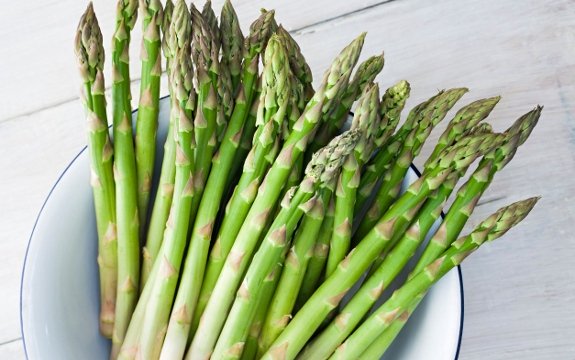6 Facts About Asparagus and Why You Should Eat More

 One of the 15 cleanest fruit (of pesticides) as shown by the Environmental Working Group, asparagus is one of many vegetables that ushers in warmer weather. Like peas and other early spring veggies, asparagus is one of the first to pop up at local farmer’s markets after a winter thaw. While U.S. families are eating more asparagus than ever, few people are hip to the many health benefits and other interesting facts about the lesser-known vegetable.
One of the 15 cleanest fruit (of pesticides) as shown by the Environmental Working Group, asparagus is one of many vegetables that ushers in warmer weather. Like peas and other early spring veggies, asparagus is one of the first to pop up at local farmer’s markets after a winter thaw. While U.S. families are eating more asparagus than ever, few people are hip to the many health benefits and other interesting facts about the lesser-known vegetable.
Here are 6 fun facts about asparagus:
- 1. Asparagus spears will grow into big bushy “ferns”. New crops of asparagus are only grown every 10 to 15 years because they are a perennial vegetable, returning every season on their own. If the spears aren’t harvested, they will unfurl similar to a fern and turn into a big bushy plant.
- 2. High respiration rate means asparagus “die” quicker than other harvested vegetables. The respiration rate of a vegetable is the rate at which a plant takes in oxygen, breaks down starche,s and releases carbon dioxide. After a vegetable is cut, it doesn’t initially die, but continues this metabolic process. Because asparagus has a high respiration rate, it has a tendency to “die” and go bad before other vegetables.
- 3. Asparagus is rich in saponins. Saponins are a type of phytonutrient credited with anti-inflammatory and anti-cancer properties. They are also able to assist in maintaining blood pressure, regulating blood sugar, and controlling blood lipid levels.
- 4. The growth rate of asparagus could reach as much as 1 inch per hour. When the weather is right, asparagus grows very fast, keeping farmers busy harvesting the spears daily if they want to keep them from turning into large inedible plants.
- 5. That whole stinky pee thing. You probably already know that asparagus can make your urine stink. It turns out, this occurrence is due to something called asparagusic acid, which the body converts into sulfur-containing compounds – that stink. But scientists aren’t sure why this strange phenomena only affects some people. Conflicting evidence exists: some suggesting it’s in perception, where everyone produces the smell but only some people can smell it; and some suggesting that only certain people produce the sulfur compounds in concentrations high enough to produce an odor.
- 6. American asparagus farmers are struggling. Close to 90% of the asparagus found in America is imported, mostly from Peru. It wasn’t always this way. According to NPR, as recently as 1989 American farmers grew more than the country consumed and exported more than it imported. Now, however, farmers in the U.S. who are holding on to growing the vegetable are finding it hard to make a living with such cheap imports. Many are destroying their crops, slicing up the spears rather than harvesting them, in hopes that they can delay production and enter the market when Mexico’s high growing season is coming to a close.
